#also mother of the spanish infantas
Explore tagged Tumblr posts
Text
Happy birthday to Elisabeth of Valois, Queen of Spain, childhood bestie of Mary Stuart, and partroness of my profile pic (Sofonisba Anguissola).
Elisabeth was apparently not a morning person and had a tendency to overspend. Here's to a real one.
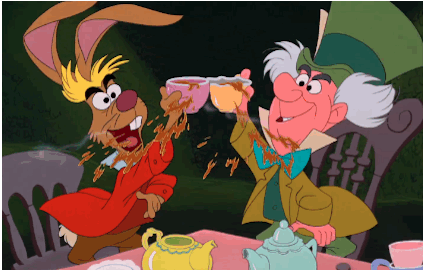
#shes so relatable#elisabeth of valois#early modern history#i think about her every time i nap#philip ii of spain#also mother of the spanish infantas#isabella and catalina
17 notes
·
View notes
Text
The relationship between infanta Catalina ‘Katherine’ of Aragon and her father, Fernando ‘Ferdinand’ II of Aragon
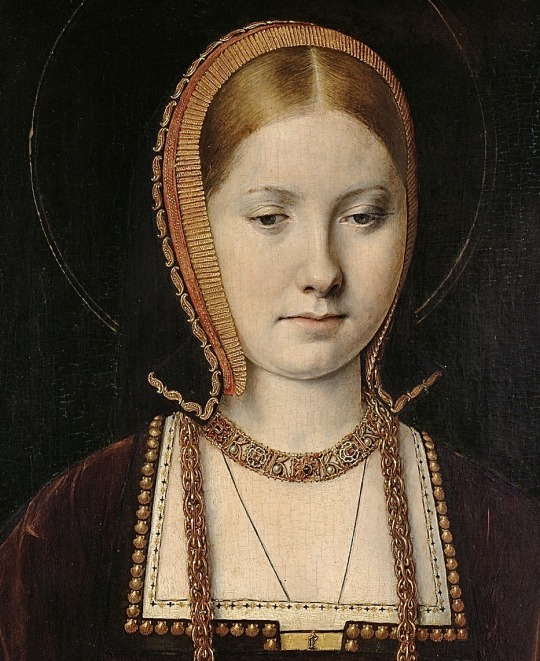

Fernando II of Aragon is known to have been a cheating husband (which, the queen, Isabel of Castile, his wife, was very aware of) and a not-so-great of a father; at least to his daughters, whom he did not care much about, seeing them as potential pawns and bargaining chips to make powerful alliances. He was, above all, an astute and cold-blooded politician and, as such, this Aragonese king was not the sentimental type of man.
It was no secret that he and the queen of Castile favoured their son and heir, Juan, prince of Asturias and Girona, over anyone else. (The queen herself would lovingly refer to him as ‘my angel’).
However, if anything has become clear to me after doing my research, is that both, the Iberian Queen and King had a soft spot for their little one, Catalina.
Queen Isabel would coddle and protect the infanta in a way she had not done with the rest of her daughters, partly due to the fact she had lost Juan and her eldest daughter, Isabel of Aragon consecutively (1497 and 1498, respectively) and partly because Catalina was her ‘baby’.
She purposely delayed Catalina’s parting to England until the very last minute, (which Fernando didn’t object to, either) and even then, she did so rather reluctantly. What is more, the queen had had the habit to accompany the infantas in their journey away from home for a little while and wave them goodbye. However, when Catalina headed for A Coruña in 1501, Isabel, either because she was feeling physically unwell or was not emotionally strong enough to do so, abstained from travelling alongside her.
Now, going back to the king.
We know the young princess would write to her father a handful of missives throughout the years, which were essentially a plea for help due to the awful state of misery she and her tiny household were in after Arthur’s premature demise in 1502.
King Henry VII was distraught by the death of his eldest son and his wife, Elizabeth of York, (the latter had passed away in 1503 after giving birth to a daughter who also died, a couple days later) and little did he care about the well-being of a foreign princess.
Not only did he fail to provide for her (the infanta had to resort to selling some of the stuff she had brought from Spain, and even then, this was not enough to sustain herself and her ladies) but also refused to return half of the dowry he had got from the Spanish monarchs, while keeping Catalina a hostage within his realm and refusing to let her return to her home country.
The situation worsened when the Castilian queen died in 1504 (aged 53) and the infanta was no longer as a desirable match as she had been when her mother was still alive.
King Fernando left many of Catalina’s letters unanswered. He did not listen to Henry VII’s demands that he paid for the rest of the princess’ dowry, either (be it because he refused to, or because he had no power to do so: his daughter, Juana, had inherited Castile, and that was where the remaining money from Catalina’s dowry allegedly was being kept. Furthermore, Fernando was not well-liked among Castilians, and his daughter, now queen, would probably not take heed of any of Fernando’s petitions for help due to the power and influence her husband, Philip of Hasburg had over her).
What Fernando did, instead, in order to improve Catalina’s welfare, was to strip de la Puebla from his title of ambassador for the Crown of Aragon in England in 1507, and grant it to his daughter, making her the first European woman ambassador in history. He would also teach the princess how to encode her letters, while instructing her thoroughly on politics, so that she could navigate the Tudor court unscathed and perform her duties as ambassador flawlessly (which we know she did).
When Henry VII died in 1509, his son Henry succeeded him to the throne as Henry VIII at 18 years old. The new young king had had the choice to marry whomever he wanted, and so, he married Catalina.
After spending seven years as a virtual captive at Durnham House in London, the whole ordeal was finally over. An extract from a letter Fernando sent his daughter after he was informed his Catalina would, in fact, become Queen of England reads: ‘(...) Porque de todas mis fijas soys vos la que mas entrañablemente amo, por vuestra virtud y merecimiento, y por el mucho amor y obediencia que conozco que como buena hija me teneys’. // ‘(…) Because, of all my daughters, you are the one I love the most, for your virtue and your merit, and for the great love and obedience that I know that, you as my daughter profess me’.
TL;DR: Despite Ferdinand II’s many faults as a husband and a father, it is safe to believe he liked and favoured his youngest child (in his own way) over the rest of his daughters.
Bibliography:
— Liss, Peggy K. Isabel the Queen: Life and Times. Second edition (Revised)., University of Pennsylvania Press, 2004.
— Pérez Martín, María Jesús. María Tudor. La Gran Reina Desconocida. Fourth ed., Rialp S.A, 2020.
— Tremlett, Giles. Catherine of Aragon: Henry’s Spanish Queen. Faber, 2011.
— Everett Green, Mary Anne. Letters of Royal and Illustrious Ladies of Great Britain, from the Commencement of the Twelfth Century to the Close of the Reign of Queen Mary I. Internet Archive. London, H. Colburn, 1970.
#katherine of aragon#catherine of aragon#usersansa#history#Tudor#disclaimer: I dislike Ferdinand as much as the next person I just wanted to give my two cents…
22 notes
·
View notes
Text

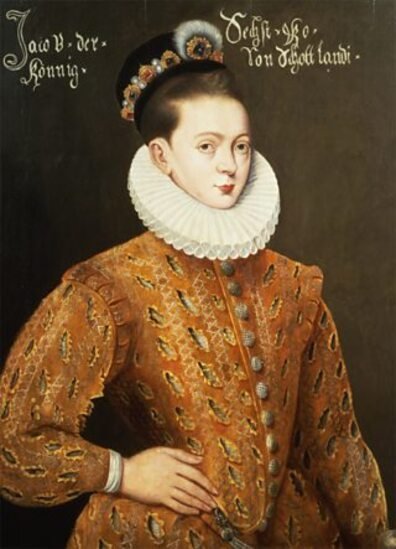

The future King James VI was born on 19th June 1566 in Edinburgh Castle.
He wouldn’t be the future King for long, in little over a year events would see his Mother being forced to give up her throne and the infant crowned monarch on July 24th 1567.
James’s tutor, the historian and poet George Buchanan, was a positive influence and James was a capable scholar.
A succession of regents ruled the kingdom, but these were dangerous times and by the time the young King was 5 two had already been assassinated, and a third a year later “took a vehement sickness" and died, some say was poisoned. The fourth and final Regent survived his term, but in 1781 he was tried for his part in the murder of Lord Darnley, the kings father, and executed.
James had become ruler in 1567, although he did not actually take full control until 1581. He proved to be a shrewd ruler who effectively controlled the various religious and political factions in Scotland.
In 1586, James and Elizabeth I became allies under the Treaty of Berwick.
When his mother was executed by Elizabeth the following year, James did not protest too vociferously - he hoped to be named as Elizabeth’s successor.
James married Anne of Denmark in 1589, three of their seven children survived into adulthood.
When Elizabeth died in March 1603 James became king of England and Ireland in a remarkably smooth transition of power., transferring the Royal court to London he only returned to Scotland once, in 1617.
One of James’s great contributions to England was the Authorised King James’s Version of the bible (1611) which was to become the standard text for more than 250 years. But he disappointed the Puritans who hoped he would introduce some of the more radical religious ideas of the Scottish church, and the Catholics, who anticipated more lenient treatment.
In 1605, a Catholic plot by Guy Fawkes and his friends to blow up king and parliament was uncovered all involved were executed.
The Stuart Monarch’s firm belief in the divine right of kings, and constant need for money, also brought him into conflict repeatedly with parliament, this would also lead to the downfall of his son, Charles I.
Abroad, James attempted to encourage European peace. In 1604, he ended the long-running war with Spain and tried to arrange a marriage between his son and the Spanish Infanta. He married off his daughter Elizabeth to the elector of the palatinate, Frederick, who was the leader of the German Protestants.
James’s eldest son Henry died in 1612, leaving Charles as heir, and his wife Anne in 1619.
James VI himself died on 27th March 1625 and was succeeded by his second son, the aforementioned Charles.
24 notes
·
View notes
Text

La Infanta Luisa Fernanda de Borbón, Duquesa de Montpensier
Artist: Federico de Madrazo y Kuntz (Spanish, 1815–1894)
Date: 1851
Medium: Oil on Canvas
Collection: Royal Palace of Madrid, Madrid, Spain
Description
María Luisa Fernanda de Borbón y Borbón-Two Sicilies ( Madrid , January 30, 1832 - Seville , February 2, 1897) was an Infanta of Spain from birth and Duchess of Montpensier by marriage.
Infanta María Luisa Fernanda was the second and last daughter of King Ferdinand VII and his wife, Queen Maria Cristina . She was born at the Royal Palace in Madrid . She was baptized at the Palace of Aranjuez . She was the paternal granddaughter of Charles IV of Spain and Maria Luisa of Parma , and on her mother's side of King Francis I of the Two Sicilies and his wife, Maria Isabella of Bourbon , also an Infanta of Spain.
#portrait#luisa fernanda de borbon#spanish royal family#federico de madrazo y kuntz#spanish painter#european art#spanish culture#19th century painting#oil on canvas#woman#costume#tiara#indoors#table#art#mirrors#veil#jewelry
10 notes
·
View notes
Note
omg wait so apparently George did sa someone?? what was his ‘relationship’ to Anne? I’m honestly curious if the show is going to include this. In all seriousness though, I don’t think they would. A lot of people have already seen George as just a victim (which in a sense yes because his mother groomed him to use his looks and seduce people to gain power and the fact that the king is 2x his age) but he also doesn’t come off across as completely innocent compared to everyone even though he might not. Im hoping people realize that this show isn’t exactly about ‘romance’ and ship George with people that he’s seducing because I’ve already seen many people just looking forward to mostly the sex part of the story. It also makes sense that they might not include the fact that George attempted to sa Anne in the show because Nicholas is playing him and will make us feel more sympathetic towards George and make King James out to be the bad guy. Honestly it’s kind of sad if they did do that (hopefully not) because the King seems like he’s been through so many traumatic experiences and add on to the fact that he’s insecure about his appearance, has several disabilities (from what I heard), and was desperate to be loved.
I hope I’m not asking to many questions! I’m just really intrigued about it:)
-✨
I don't think they'll show for a simple reason: it happened after the Season Finale.
the last episode is titled "war" and it's implied that the war is the Thirty Years' War, who started in 1618 and involved in his first phase Elizabeth Stuart, james's daughter.
The Amiens night happened in 1616 so... it's difficoult to show it, like the spanish escapade.
George&Anne, so...
They met each other in 1622, during tyhe spanish escapade when george and Charles, at time prince of Wales, travelled to Madrid via France. He found her very beautiful and he wrote to James "if the Infanta is beautiful as his sister we will have a beaitufil queen".
Then they see when george arrived in paris to escort Henriette Anne to London and the flirt, innocent for her, not so inncent for him. She even said "he's the the only man that I can love" but it was a courtley love for her.
The in Amiens he succed to talk with her, alone, thanks to Anne's friend the dutchess of Chevreuse, and... it happened. He tried to kiss her, she refused, he couldn't understand why, he belived " a no is a yes" 'cause no one in over 10 years had dare say no to him, so he continued.
She refused, she fell and he was on top of her, pants down and trying to lift her skirt when her ladies in witing and her butler, found them.
the next day he tried to apologise but the queen mother Marie de'Medici ordred that her daughter had to leave immediatley and never be alone with hime, she and Anne returned to Paris the same day
George was a victim and a culprint too, and this episode really showed that. H was a victim 'cause for 10 years he was spiled by the court, by the prince of wales and by the king so he never heard a no, and he was a culprit 'cause he tried to rape a queen 'cause he cannot understand why a woman could reject him
#mary & george#mary and george#george villiers#queen anne of austria#anne of austria#james i#james vi#james vi and i
4 notes
·
View notes
Text

𝐰𝐢𝐭𝐡 … maria de mendoza ( @mendozaed ) 𝐰𝐡𝐞𝐫𝐞 … chelsea house , london .

the dowager duchess of suffolk had always spoken highly of katherine of aragon and of the women that had followed their princess from the perfumed warmth of the alhambra to the fever - stricken halls of ludlow and then to the foggy dampness of london ─ weaned on her mother's esteem of the spanish infanta, katherine brandon had filled the minds of her impressionable young daughters with an admiration for their iberian neighbours that only grew more fierce with the death of her royal namesake. philippa could still recall the disappointment that had leaden her young body at the realization that she was much too young to follow mary tudor from calais to spain as part of her royal entourage, so it was with no small amount of fascination that she presented herself before the duchess of medina, head dipping into a nod of acknowledgment as the doors parted to announce her arrival. chelsea house had hastily been made available for the use of any spaniards who wished to elude the viper - infested corridors of hampton court but though it served as an assembly of like - minded persons, there was only so much that she could offer to her guests and her visit was more apologetic than she would have preferred, hands folding above her stomach as her steps quickened towards the older woman to greet her properly.
❝ doña maria ... i am certain that my lady mother has ensured that you lack for nothing but i would be a poor hostess if i did not inquire if there is anything else we might offer to make your stay in chelsea house more pleasant. ❞ faced with such a formidable woman, philippa could not help but be reminded of her mother and her grandmother, from what faint memories she had to mary tudor brandon before the queen of france and princess of england had passed just two years after her birth and the recollection brought a sense of attentiveness upon her, softening her sharp gaze into something that was more watchful with a curiosity to learn. though her mother had still held much power as dowager duchess, it was philippa who served as the figurehead for many catholic sympathizers in england now that mary of england had left to become mary of spain and she wanted her foreign cousins to know that she assumed the role with the severity that it deserved in the hopes of gaining their support or protection should the boleyns pass the action to curtail her rights as a claimant to the throne.

❝ i also wished to extend my apologies for my failure in finding a catholic priest to attend to the needs of the infante and infanta and yourself, of course, and i wanted to inquire if one was forthcoming from spain to preside over mass services in chelsea house ? ❞ it was treason to celebrate a catholic mass in england and to do so beneath the king's nose would be stupidity but she was not certain if exceptions would be made for their catholic guests or if the spaniards would do as they pleased regardless of the king's feelings ─ either way, philippa needed to be made aware if such plans existed, if only to capitalize on the moment.
#𝐏𝐇𝐈𝐋𝐈𝐏𝐏𝐀 𝐆𝐑𝐄𝐘 ♔ ˚ · . [ interactions ] .#:polite: emoji#mendozaed#this entire starter is just pippa being pro KOA huh
4 notes
·
View notes
Photo


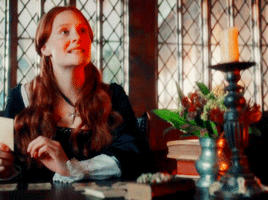
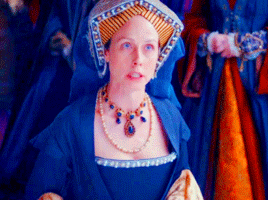

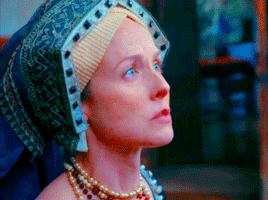
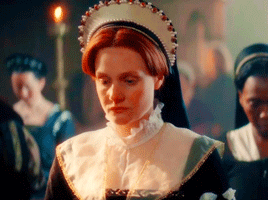

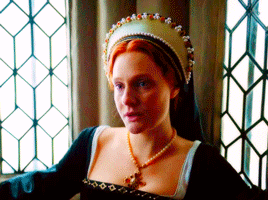
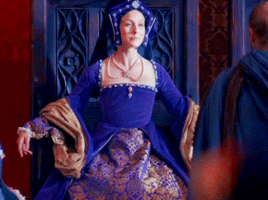
"Mary’s relationship with her mother is key, and Katherine must be understood not as a weak, rejected wife but as a strong, highly accomplished, and defiant woman who withstood the attempts of her husband, Henry VIII, to browbeat her into submission and was determined to defend the legitimacy of her marriage and of her daughter’s birth. [...] Katherine of Aragon can be understood as a figure of immense courage from whom Mary could learn much. Katherine oversaw Mary’s early education and highly formative upbringing, which was not a prelude to inevitable failure but an apprenticeship for rule. Mary’s Spanish heritage informed her queenship but in a far more positive way than is popularly acknowledged."
- Anna Whitelock, Mary Tudor: Princess, Bastard, Queen
"In some ways, this letter resembles the “mirror of princesses” literature, most strikingly Anne de France’s 'Lessons for My Daughter', written around 1504. Like Anne, a French princess and regent for her brother King Charles VIII, Catherine makes a strong case for virtue, not only the specific feminine virtue of chastity but also the more general virtues of filial love and obedience, all of this tempered by a strong sense of ethical responsibility and reliance on trustworthy friends. Catherine’s expressions of maternal love are wrapped skillfully around carefully worded advice on how to handle the news. Her advice to Mary on how best to navigate dangerous political dynamics is also a brief summary of Tudor queenship written at a key moment in English history. As a political statement, in this brief lesson on Tudor queenship, she shares with Mary the contradictions and responsibilities of queenship. [...] Her signature also conveys love of the realm and care for the institution of queenship. She was protecting Mary as the princess who would be queen. She knew that a queen was expected to be a noble, beautiful, virtuous, and chaste protector of her family. These sentiments are familiar: duty and humility. These ideas on queenship in this letter are intertwined with those of kingship. [...] Catherine also was a realist with an unwavering conviction, based on the example of her mother, that Mary could rule legitimately in her own right."
- Theresa Earenfight, Catherine of Aragon: Infanta of Spain, Queen of England
Happy Birthday Magdalena! @latristereina
#mary I#mary tudor#perioddramaedit#weloveperioddrama#catherine of aragon#katherine of aragon#historyedit#becoming elizabeth#becomingelizabethedit#six wives with lucy worsley#perioddramasource#english history#*mine#big thanks to Sol for the scenes from Lucy Worsely's documentary <3#taken from mykpacks on IG
530 notes
·
View notes
Photo










And in Alcalá, on December 15, 1485 was born the infanta Catalina, the last of Isabel’s children. “The birth of a son,” says Palencia, “would have caused los reyes greater happiness, for a succession depending on an only son inspired no small fear, and the fecundity of their daughters boded difficulties for future relationships.” That is, the birth of another daughter increased the dreaded possibility of disputed succession. Even so, of all the children, Catalina would most resemble her mother.
- Peggy K. Liss, Isabel the Queen: Life and Times
The ambassadors also saw mock skirmishes and running with dogs ‘in the way they fought with the Saracens [that is, the Moors]’. Machado spent much of his time watching Isabella, who had little Catherine with her, marvelling at how affectionate and attentive she was. ‘It was beautiful to see how the queen held up her youngest daughter,’ he noted.
- Giles Tremlett, Isabella of Castile: Europe's First Great Queen
Her idyll, if that was what it was, came to an end in the late spring of 1501. The future princess of Wales had been expected in England eight months earlier (when her husband-to-be turned fourteen), but Isabel procrastinated. An Italian visitor who reached Granada late in 1500 reported that Catherine had been ill, though she was well enough to receive him on New Year’s Day 1501. It still, however, took her several months to set off for England.
Isabel was, perhaps, unwilling to part with her last child. Catherine was younger than her sisters had been when they left. Eight months earlier she and her parents had gathered at the old royal encampment of Santa Fe – near to Granada – to say goodbye to María. The sister she was closest to, the one she had grown up with, went off to marry the king of neighbouring Portugal. She was a replacement for her deceased elder sister Isabel.
- Giles Tremlett, Catherine of Aragon: Henry’s Spanish Queen
Happy Birthday, @queenmiriamele!
#perioddramaedit#historyedit#women in history#katherine of aragon#isabella of castile#isabel tve#3x10#natalia rodríguez#michelle jenner
187 notes
·
View notes
Photo

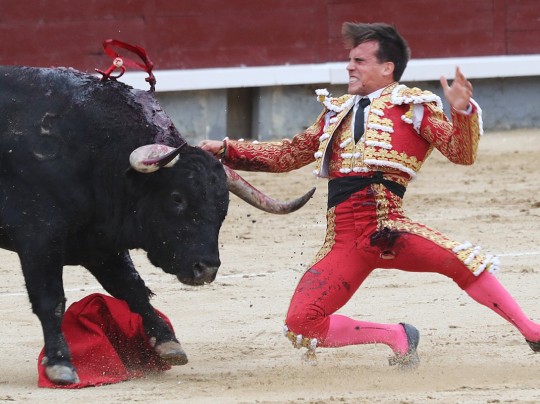
Toreros must also be accustom themselves to a career which will inevitably involve injury by goring: sometimes serious, if not grotesque, goring. No matter what your personal opinion of the corrida may happen to be, these facts are inescapable: in the corrida, bulls and men meet fear and pain and both may die.
- A.L. Kennedy, On Bullfighting
On 12 Oct 2018, in Las Ventas bull ring in Madrid, during a bull fight, the torero Gonzalo Cabellero was thrown in the air and then struck for a second time between his legs by the bull which he had stabbed in the neck with a dagger and hit in the back with three spears.
The 27-year-old's femoral vein was ruptured and he was left with two wounds reportedly between 25 and 30cm deep.
Bleeding heavily from his groin, as he was carried out from Madrid’s Las Ventas bull ring, his girlfriend at the time was Victoria Federica - daughter of the Infanta Elena and granddaughter of King Emeritus Juan Carlos, making her fifth in line to the Spanish throne - who watched on.
Cabellero survived. Barely. He was operated on for more than two hours before being taken to San Francisco de Asís hospital, Madrid where he received intensive medical treatment.
The young bullfighter of Torrejón de Ardoz was seriously injured when he killed his first bull. With major muscle damage and the prospect of being infirm permanently, his life was destroyed in a matter of a few fatal seconds in the ring.
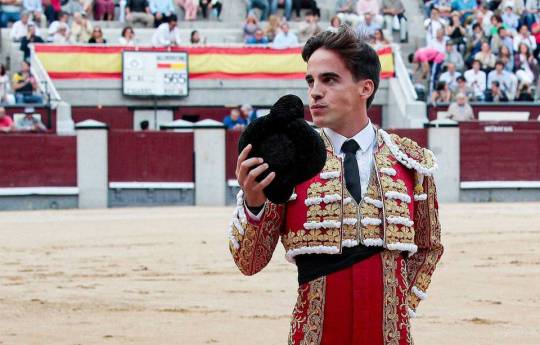
Caballero later said, “I noticed how I was turning off and I was out of breath, I also felt the tap of hot blood on the hand with which, almost unconscious, I tried to plug the wound; it is very hard to say but I came to assume that I was going, that's why my The last words before falling asleep was that they told my mother that I loved her very much. I have come to feel totally defeated and eager of abandoning everything….When I saw myself as I saw myself, and, above all, when they told me that I was suffering from a very hard kidney crisis and that I could stay for life connected to a machine, I came down, I started crying like a child and felt for the first time in My life that I had lost, that the bull Claverito I had won the game.”
The Claverito the bull was killed shortly afterwards and its ear cut off and delivered to the injured the injured matador as a trophy, in keeping with tradition.
#al kennedy#kennedy#quote#bullfighting#art#spain#tradition#torero#heritage#bull#injury#death#custom#society
39 notes
·
View notes
Text
The birth of an Empress & Powerful Regent.

24 October 1503: The birth of Isabelle of Portugal. She was the daughter of King Manuel I & María of Aragon. She married Charles V, Emperor of the Holy Roman Empire and King of Spain in 1526. The two had three children that reached adulthood including King Philip II of Spain and I of Portugal.
Both she and her husband shared the same maternal grandparents: the Catholic Kings, Fernando II of Aragon and Isabel I of Castilla.
It's not a popular or mainstream fact that Empress Isabella was among the most learned, headstrong women of the sixteenth century. While her husband was away from Spain, she was left in charge of ruling Spain in his name. While this was not unheard of, Isabella's skills and diplomacy set her apart from other female regents and royal consorts of her era. Not donning armor or heading into battle, she was actively involved in domestic and international affairs. She oversaw all aspects of Spanish government and her children's education and upbringing. Perfectly knowing what was expected of her, she balanced her public persona with her private one. Filial love, loyalty and other feminine royal virtues were balanced perfectly with her ambition, intelligence and fierce determination.
Her tact and sharp wit made her appear like an indomitable figure in politics, overseeing all of her husband domains without usurping his authority or overshadowing him. The end result was of a power couple that had mutual affection and respect for one another.
Additionally, Isabella also brought a much needed stability to Charles V in his Spanish domains. Due to her being a Portuguese Infanta, she was more in tune with the customs of her adoptive land than her husband.* She also ensured that their future monarch, her son Prince Philip of Asturias, would be raised in Spain, thus being culturally Spanish and Portuguese in every form his future subjects expected from their rulers.
Carlos, Rey Emperador, the series sequel to the Spanish hit TV series Isabel, explored their relationship in the first half of the series.
*Charles was a teenager when he and a select few of his bones arrived on Spain in 1517 after his maternal grandfather, Fernando II of Aragon, passed away. Although technically his mother Juana I of Castilla was the lawful ruler, her alleged mental state remained a topic of concern. As a result, the crown was in dispute between the Spanish born and raised younger brother of Charles, Ferdinand and Charles himself. Charles didn't know one word of Spanish, wasn't familiar with Iberian culture and Spanish customs. His step-grandmother and soon turned lover, Germaine de Fox, helped him with his transition but it wasn't enough. Revolts and discontent quickly brewed. To his credit, Charles did come to learn the language and customs and introduced Castiglione's manual for courtiers and refined manners found in Charles' homeland to Spain which became as much a part of their culture as anything else preceding it. His marriage to Isabella was more than a political match. He needed someone they could accept and not see as foreign in order to appease them. This turned a wise move, not just for his reign but for the two as well. Isabella and Charles came to have genuine affection for one another and many speculate, also came to love each other. When she died in 1539, Charles mourned her deeply.
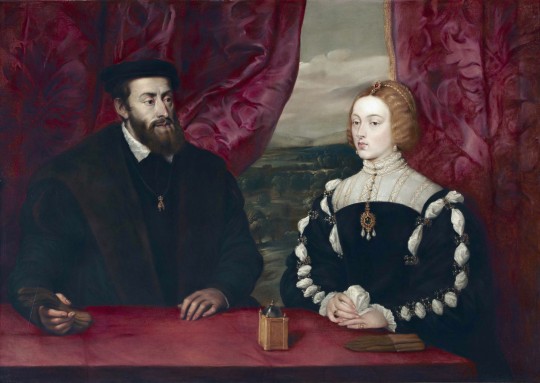
#isabella of portugal#portugal#spain#history#Renaissance#charles v of the holy roman empire#sixteenth century#non daily tudors
57 notes
·
View notes
Text
The Spanish Princess Season 1: A ridiculously long review
I finally watched The Spanish Princess, everyone's favorite hate watch of 2019-2020. The last instance (thank God) of the infamous Gregoryverse, this series is a sequel (kinda?) of the mini series The White Princess, who in turn is a sequel of The White Queen. It is also... something else entirely.
Everything bad about this show has already been said: it's trash, it's full of misoginy, it's inaccurate in a way that's offensive to the people it portrays, the characters are unlikeable, the pacing is terrible, the costumes are dreadful, it's just a really bad written TV show. I am saying nothing new. And yet, I felt compelled to write a review, because I think that the reason why this show was terrible in a way that neither TWQ nor TWP were can be traced back to a single thing: ageing up Prince Henry. This had such a domino effect that created a problem that wasn't present in the previouse series, therefore making it bad even for the standards of the Gregoryverse. The problem being that Catherine's story doesn't work at all with Henry being of marriageable age.
Hear me out: had Henry been older when Arthur died, he would have married Catherine the moment their parents made the new agreement, and that would've been it. The precarious situation in which she ended during her years as a widow simply wouln't have happened. You can't have that story with growed up Henry. Or at least, you can't have that story while still making sense. And this was the main problem: they still wanted that story, so they made it and it made no sense. And I'm not even talking about not making sense because it's not historically accurate, just not making sense within the shows' universe.
Let me give you an example: in The White Princess it was stablished that the Infanta's hand was a prize worth killing for. Actually, even if we ignore TWP, in the first episode of this show they established that Catherine and Arthur's marriage was crucial because Spain was an extremely rich and powerful country and England a broke and backward one (pretty sure this is untrue). Not only that, even Catherine's Lancaster ancestry (namely being a great-great-great granddaughter of John of Gaunt) and the exacutions of the Earl of Warwick and Perkin Warbeck were brought up. She is important and key to the Tudors, they need her. And yet the second Arthur dies suddenly she is useless, everyone hates her and wants to inmmediately get rid of her. Why? Why are they going against everything that was established one episode ago?? It makes no damn sense.
The show tries to give very lame excuses to this: from Elizabeth of York having a prophecy (???) about Catherine and Prince Henry's marriage being doom to produce no sons to Margaret Beaufort just hating her for no reason at all. But the real answer is painfully crystal clear: Henry is old enough to marry Catherine. They have to invent these stupid reasons and contradict their own logic because if they didn't, there wouldn't be any conflict in the show. So now it's not that Catherine can't remarry Henry because he is a literal child so she has to wait, and during those years of waiting the political landscape of Europe changes so much that she is no longer an attractive bride for England anymore, but that the King's Mother is evil and gets in the way of Catherine and Henry's true love because she doesn't like her!
Which leads me to the second biggest problem of the show: Margaret Beaufort being the main villain makes no fucking sense. I know that Philippa Gregory has a personal vendetta against her, and that these trashy adaptations do nothing but further the slander towards Margaret but MY GOODNESS the way this series goes above and beyond to paint her as evil is just vile. And a problem, because it doesn't work. Take The White Queen: since we followed characters from different factions, while there were "evil" characters, there weren't really villains, just people who ended up in the opposite sides of the battlefield. And that worked because they all strived for the same prize, the English throne, and put their lives in line for it. In The White Princess our main villains are the Duchess of Burgundy and Perkin Warbeck (although here he is actually Richard, Duke of York), and once again, it works because they want to depose our main characters and take revenge against them (no matter how much Emma Frost and co tried to make us believe that Warbeck was good and loved his sister, there is no way that he was just going to let go his nephews as if nothing lol). Meanwhile, in The Spanish Princess the main villain is Margaret Beaufort, because she wants to... send Catherine back to Spain because she has an irracional hatred towards her. That's it. That is literally the biggest danger Catherine faces: that she may be sent back home.
It just doesn't work. We went from pretenders to the throne that put our main characters' lives at risk to grandmother-in-law from hell doesn't like our protagonist. The stakes are so low it's ridiculous. And it's even more jarring when we all know were this is going. Elizabeth Woodville and Elizabeth of York may be more unknown to the general public, but most people have at least a vague idea of who Catherine of Aragon was. Every episode's cliffhanger after episode 2 it's "Oh no, something happened that will prevent Catherine from marrying Prince Harry!! Will she ever become Queen now??" and it's really stupid because the answer is yes, of course she is going to become Queen, she is Wife Number 1, divorced, you literally sold this show as the story of Henry VIII's first and true love. We know that. There is nothing engaging in watching a show that drags the unavoidable for six episodes and give us nothing else.
Because even though this show really wants you to feel sorry for Catherine and root for her, it also has a weird reluctance to actually showing us Catherine struggling with her undefined status after Arthur's death. Everyone is rude to her! She has to choose between old king Henry and his young son! Her mom wants her to go back home to live like a princess! She got send to a small apartment! She doesn't know if Harry truly loves her! And it goes on and on until she marries Henry. And yes some of these things are kinda bad, but they never feel... actually difficult? Like you never feel that Catherine is going through a hard time, because the show never pushes her too much out of her confort zone. This comes directly from the already mentioned biggest problem of ageing up Henry, because now Catherine isn't in a limbo in which she has no idea what's going to be of her for seven years, but only for a couple of months. For real, there isn't any indicator that even a season has passed, since the weather never changes. This season might as well take place in a single month for all we know.
The series also has a very anti-Tudor sentiment, which was also present in the two previouse instance of the franchise, but here comes off as weird: we are meant to see the Tudors, personified by Margaret Beaufort, as tyrants, impostors and simply unworthy of rulling England. King Henry is an uncapable ruler dominated by his ruthless mother (remember the whole character arc he went in TWP in which he separate himself from the influence of his mother? no? well, neither did the screenwritters) and the whole country hates them. Edmund de la Pole, the Yorkist pretender of the hour, lurks through out the entire season, but no one actually cares except for Margaret Beaufort and sometimes King Henry (and that's bad for some reason). It's just weird how he isn't threatening at all, given that it is crucial for our protagonist that the Tudors remain in power. But no, the screenwritters love the Yorks so much that even when de la Pole should be the greatest concern to Catherine, given that all the trouble she is going through to marry Prince Henry would be for nothing if his family gets deposed, he is merely Margaret Pole's friendly cousin that wants to help her by overthrowing the tyranic Tudors. Maybe it's just me, but I found strange how we are still asked to dislike the Tudors while simultanously root for our protagonist to marry into said family.
Also, another thing that I think was a failure is the fixation on Catherine lying about having consummated her marriage to Arthur. I don't think the real Catherine lied, but that's not the point: it is yet one more thing that doesn't work because of how known Catherine's story is. Episode after episode, there's always some variant of "Oh no, Catherine lied about being a virgin!! Will this ever come back at her??" and the answer once again is yes, we all know this. And it's also just annoying hindsight, because whether Catherine slept with Arthur or not wasn't important until Henry decided to base the annulment of his marriage to her in that fact. I think Catherine lying would've work better if we, the audiance, were made to believe that nothing happened until the season finale. You know that final conversation in which Catherine swore to Henry that she never slept with Arthur? Just imagine the impact that the scene could've had if it was revelead right then that Catherine did consummated her first marriage, and that she had been lying to everyone, the audiance included.
Overall, I actually think that Catherine's widowhood could have made for an interesting TV series, but the way they handle it just resulted in an uninteresting, predictable, utterly boring show. That was my biggest surprise watching this: how dull it is. For all their problems, TWQ and TWP were very entertaining series, and even when I was yelling at my scream for something awfully inaccurate that was happening, I was engaged in the story. Here I got bored in episode four, and I continued to be bored until the end. The story really has nothing to offer: just going on circles about whether Catherine will marry Henry or not, while the characters remain exactly as they were at the beginning. I could and I have more to say about this disastrous show, but the review is already ridiculously long, and anyway I'm not bringing anything new to the table. I am a completionist, so even though I didn't enjoy this series at all, I will watch the second season. Oh well, at least I'll get to see more Hot Thomas Boleyn, so it won't be all suffering.
My score: somehow they managed to make a TV show that makes The Other Boleyn Girl (2008) look like a not terrible movie in comparison
#don't get me wrong tobg sucked but at least it lasted only two hours and not EIGHT#also the fact that I still have so many thoughts that just didn't make it here because I got tired of writing...#well I don't think anyone will actually read all of this in the first place so it doesn't really matter#the spanish princess#my reviews
31 notes
·
View notes
Photo
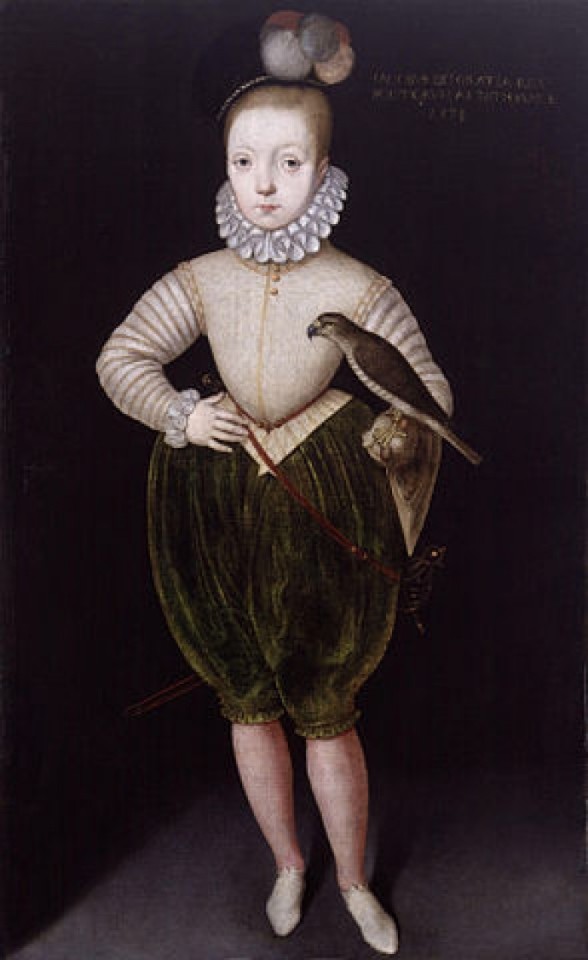
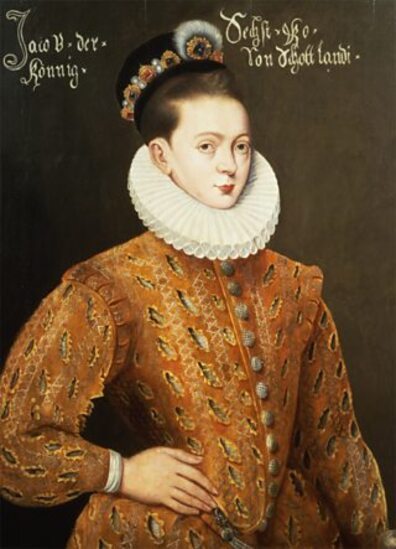
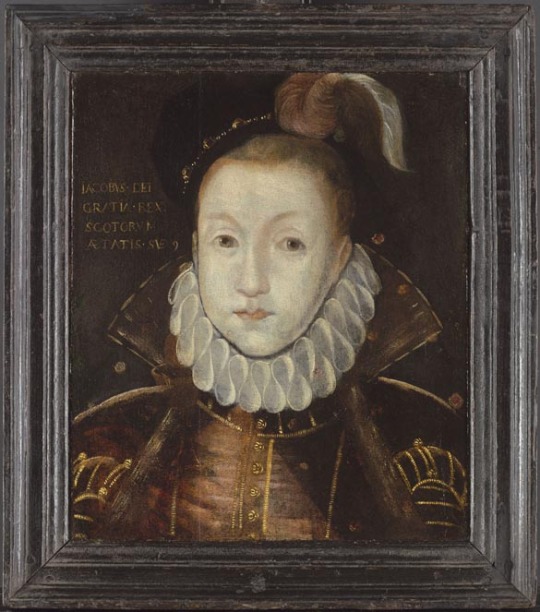
The future King James VI was born on 19th June 1566 in Edinburgh Castle.
He wouldn’t be the future King for long, in little over a year events would see his Mother being forced to give up her throne and the infant crowned monarch on July 24th 1567.
James’s tutor, the historian and poet George Buchanan, was a positive influence and James was a capable scholar.
A succession of regents ruled the kingdom, but these were dangerous times and by the time the young King was 5 two had already been assassinated, and a third a year later “took a vehement sickness" and died, some say was poisoned. The fourth and final Regent survived his term, but in 1781 he was tried for his part in the murder of Lord Darnley, the kings father, and executed.
James had become ruler in 1567, although he did not actually take full control until 1581. He proved to be a shrewd ruler who effectively controlled the various religious and political factions in Scotland.
In 1586, James and Elizabeth I became allies under the Treaty of Berwick.
When his mother was executed by Elizabeth the following year, James did not protest too vociferously - he hoped to be named as Elizabeth’s successor.
James married Anne of Denmark in 1589, three of their seven children survived into adulthood.
When Elizabeth died in March 1603 James became king of England and Ireland in a remarkably smooth transition of power., transferring the Royal court to London he only returned to Scotland once, in 1617.
One of James’s great contributions to England was the Authorised King James’s Version of the bible (1611) which was to become the standard text for more than 250 years. But he disappointed the Puritans who hoped he would introduce some of the more radical religious ideas of the Scottish church, and the Catholics, who anticipated more lenient treatment.
In 1605, a Catholic plot by Guy Fawkes and his friends to blow up king and parliament was uncovered all involved were executed.
The Stuart Monarch’s firm belief in the divine right of kings, and constant need for money, also brought him into conflict repeatedly with parliament, this would also lead to the downfall of his son, Charles I.
Abroad, James attempted to encourage European peace. In 1604, he ended the long-running war with Spain and tried to arrange a marriage between his son and the Spanish Infanta. He married off his daughter Elizabeth to the elector of the palatinate, Frederick, who was the leader of the German Protestants.
James’s eldest son Henry died in 1612, leaving Charles as heir, and his wife Anne in 1619.
James VI himself died on 27th March 1625 and was succeeded by his second son, the aforementioned Charles.
8 notes
·
View notes
Text
Cristobal Balenciaga
Cristobal Balenciaga was born in 1885 in Getaria which was a small fishing village in northern Spain. His mother was a stream stress which is how he ended up getting into fashion. He watched her and her clients which where the most fashionable and glamourous women in the village. At the age of only 12 he begin an tailoring apprenticeship in the neighbouring fashionable resort of stan Sebastian. This is where it all started for him as his first fashion house in 1917 named after a shortening of his mothers maiden name- Eisa. Balenciaga opened fashion houses in Barcelona and Madrid before moving to Paris in 1937 the fashion houses (Avenue Georges V) quickly became the cities most popular, most expensive and exclusive couturier. With the apprenticeships and his mother being a seamstress this training help set him apart from the other big designers of his time. With Cristóbal Balenciaga the design process for him started with the fabric not the sketch “it’s the fabric that decides” he stated, showing he could manipulate the materials to show there very best effect. Balenciaga knew the craft inside out and was adept at every stage of the making process. Balenciaga's Spanish heritage influenced a lot of the iconic designs. The wide hipped ‘infanta’ dress from his 1930s collection drew inspiration from the 17th century Spanish artist Diego Velázquez. In the later phase of his career, in the 1950s Balenciaga was pioneering with new shapes never seen before in the women's fashion industry. The radical designs developed season by season as he redefined and reworked at the looks created his style and a name for himself and his fashion house. In 1957 he shocked the fashion world with the introduction of the 'sack dress', a straight up and down shift dress which completely eliminated the waist. At a time when Christian Dior's hour-glass shaped New Look was still dominant, the 'sack' was initially met with hostility from both clients and press. "It's hard to be sexy in a sack!" cried the Daily Mirror. Like many of Balenciaga's most radical designs, this look eventually filtered into the mainstream. The sack dress was the forerunner of the ubiquitous mini-dress of the 1960s and remains a fashion staple today. He then retired and past on the fashion house, however Balenciaga came out of retirement in 1972 to create the wedding dress of Spanish aristocrat and socialite María del Carmen Martínez-Bordiú , he sadly passed two weeks after this.
youtube
youtube
Product- Balenciaga has had many collection over the year all by different designers but all the product and innovative designs and one on there own, they have women and menswear, something for everyone with each collection they bring out. The brand has ready to wear items, leather goods, shoes, bags and apparel for men and women
Price- Balenciaga's is a brand based on luxury items meaning their prices are very expensive so there have a small group in their target market and very few people can afford to pay the extreme amount of money for just one items.
Place- Balenciaga sell they product online and in store however their main source for purchasing their items is probably online as everyone can access this and is the most relevant way to buy anything now and will be for a long period of time. The items in store are very limited as not a lot of store carry items like these as such as luxurious at Balenciaga's products.
Promotion- Balenciaga advertise in big cities such as Mumbai, New Delhi and Chandigarh just a few examples, they do a lot of celebrity marketing this is such a clever idea to promote a brand as when people see big celebrities wearing the brand, they immediately want to own that, Balenciaga did this with Kim Kardashian she wore a lot of Balenciaga recently which was such a smart idea as Kim is so relevant and on trend now. They also use a lot of social media which is probably the most relevant way of promoting these day as everyoneis using social media and doing campaigns on social media you know everyone will be seeing this and if people are liking and sharing this they can use this of a way of feedback for the company.
youtube
Nicolas Ghesquiere took a freelance job that took him to Balenciaga in 1995, when the Balenciaga creative director Josephus Thimister however he was fired two year later, and Nicolas tapped in and it was the start of his 15-year run at Balenciaga. Nicolas reportedly doubled the income of Balenciaga's sale when arriving. Whilst at Balenciaga he delivered us the 1980s inspired fashion and the iconic lariat handbag, he went on to expand the number of collection for Balenciaga and continued to produce innovative design such as the short gladiator style skirt and the toga dresses, knee high gladiator sandals and so much more like collections inspired by some of Balenciaga's original designs.
youtube
Balenciaga’s target audience is men and women who live a luxury lifestyle and prefer a different side of sophisticated, however now the time and generation has changed the new target audience is the new generation of fashion enthusiasts. All the customers that buy Balenciaga's products are aware of the trends in fashion and the fashion world of this generation. The target market for Balenciaga is a very wealthy group of people due to the high prices of all the products and especially if they are buying straight of the runway and the ready to wear collection.
Spring 2016 ready to wear runway is my favorite collection. The collection was designed by Alexander Wang just before he left. His final runway called swan song was said to be the freest collection he did for the house. All this collections was made entirely from shade of ivory, all in soft natural fabrics like linen cotton. All the designs looked effortless . The work for this collection started after the announcement that Wang would not be renewing his contract to the Balenciaga fashion house. His las collection was his best collection, some people believe this was because he let his guard down due to it being his last and wanting to focus on creating a signature label of his own. Although the vibes around this collection is very relaxed a lot of smocking, ruching and ladder stitching went into creating this collection while remaining light. I think the entire collection is so beautiful and elegant with also a bit of edge thrown into the mix which make it so interesting and caught my attention when looking through all the collection of Balenciaga throughout the year, this is with out a doubt my favorite, due to the effortlessly pretty vibes it has and all the shapes within the collection.
youtube
youtube
Harvard referencing
V&A () introducing Cristóbal Balenciaga[online] available from https://www.vam.ac.uk/articles/introducing-cristobal-balenciaga [accessed 7th November 2022
Britania(16th April 2016) Nicolas Ghesquière[online] available from https://www.britannica.com/biography/Nicolas-Ghesquiere [accessed 14th November 2022]
Elle (25th May 2017) A Look Back At Balenciaga's Most Iconic Moments Through History[online] available from https://www.elle.com/uk/fashion/trends/articles/g31790/balenciagas-most-iconic-moments/ [accessed 14th November 2022]
Vogue(2nd October 2015) Balenciaga Spring 2016 ready-to-wear [online] available from https://www.vogue.com/fashion-shows/spring-2016-ready-to-wear/balenciaga [accessed 14th November 2022]
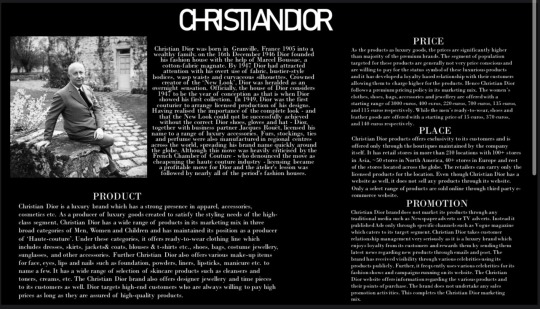
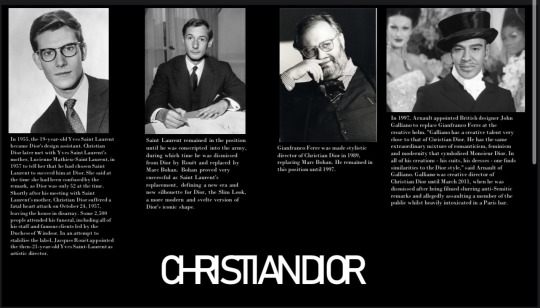


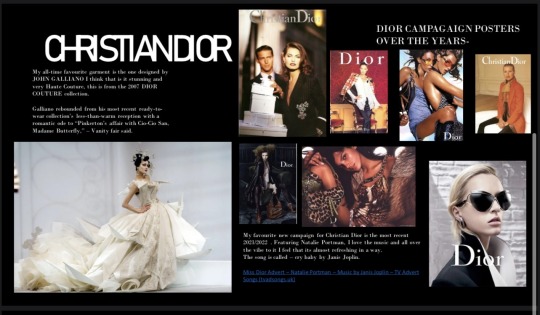

3 notes
·
View notes
Photo
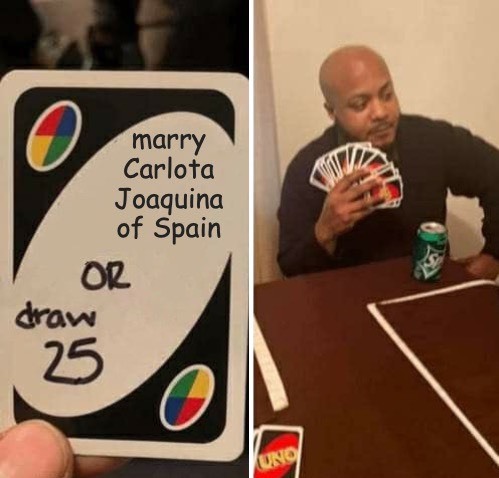


Did You Know: The House of Bragança Edition #6
“De Espanha nem bom vento, nem bom casamento” (Neither good winds nor good marriages come from Spain), but nothing could have prepared Portugal for this Spanish spouse.
Doña Carlota Joaquina was the wife of D. João VI of Portugal and Queen of Portugal between 1785 and 1826. As the oldest surviving child of King Charles IV of Spain, she was married to D. João when she was only 10 while D. João was 18.
Despite any initial affection that might have existed between the king and the young queen, most of their relationship was characterised by deep hostility and paranoia.
Throughout her life, Carlota had plotted to have her husband declared insane like his mother, D. Maria I, so that she would become regent. D. João eventually discovered her plot against him, and put a stop to it.
Aside from her scheming personality and loathing for her husband, Carlota’s unattractive appearance did not help her reputation. The Portuguese Court’s initial reaction to her small body was: “We sent them a fish and they sent us a sardine!” (p.179). The fish in question was Infanta Maria Vitoria of Portugal who married the Spanish Infante Gabriel. The double marriage was meant to better the diplomatic relationship between Spain and Portugal.
Unfortunately, Carlota had only reaped the antipathy of the Portuguese Court and people for her eccentricity, promiscuity, scheming personality. She also meddled in Portuguese politics, oftentimes in opposition to her husband.
This goes to show that the first Portuguese saying as well as the Spanish saying “Mejor amancebada que mal casada” (It is better to be a concubine than badly married) holds a lot of truth.
#Did You Know: The House of Bragança#carlota joaquina of spain#carlota joaquina#house of bragança#house of braganza#Portugal#Portuguese history#she's the villain that Hollywood movies and telenovelas NEED#D. João VI#my entries
4 notes
·
View notes
Text
Her family Part 3-Juana I’s depictions
Juana was very interesting character, on one side this very smart highly educated woman, on other side woman who got labelled as crazy.
And also woman who is frequently depicted looking nothing like she trully was!
She is always thought about as brunette. Yet she is just another victim of darkening of portraits.Her hair, was golden like mum and youngest sister. Dark shade of golden strawberry blond.
Johanna "die Wahnsinnige" (1473-1555)/Juana the Mad by Juan de Flandes, c. 1500, Kunsthistorisches Museum in Wien, Austria:

(Museum also has matching portrait of her husband Philip.)
This one in particular shows the strawberry blond hair very well and she is adult(around 21). Her hair was highly unlikely to change anymore, and certainly wouldn’t turn into dark brown.
I am not exactly sure what is going on with the fashion, headwear is not spanish, dress looks like it could be lower gown, yet at same time there are differences in shape etc. Logically it should be Burgundian(actially Flemish /Neatherlandish) or German fashion, because that was fashion of court ofher husband and of her father in law, Emperor Maxmilian.
Enjoy the rest of Queen Juana’s depictions. :-)
This painting is thought by many fans to be Catherine, but sitter doesn’t have her tip of nose. It’s too much narrower. (Mary I as child visibly had her mum’s nose tip, hence her mum as child should have it too!)
Juan de Flandes arrived to Spain cca 1496. It has to be one of Catherine’s older sisters still in Spain around that time, and that leaves Juana(16) or Maria(14). We know Juana had this narrow nose, this shape of eyebrows, these ears, these lips, this shape of forehead, shape of face, so I am going with Juana.
Portrait of Infanta by Juan Flandes-cca 1496(she’d be 16th and rose bud could be symbol of her upcoming marriage)
before removal of yellow varnish:

After:
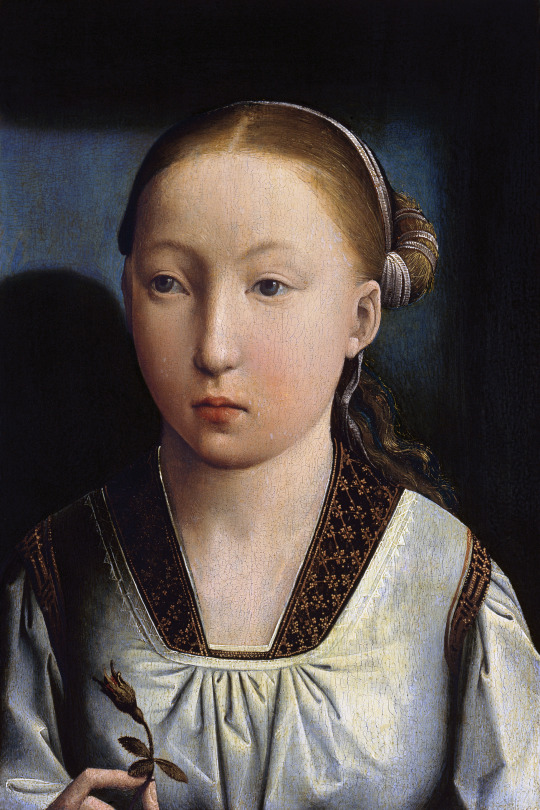
There are many way more reddish hair versions circulating only but this is the real deal and really hair into golden shades of strawberry blond.
(Don’t mind the changing colour of eyes between these two portraits. Very often painters used cheaper pigments to make eyes(because blue ultramarine was expensive and for just tiny detail they didn’t want to bother) and often they darkened(to brown) or faded to grey or greyish.)
There is actually third portrait where her hair is not darkened:
The Virgin of Mercy with the Family of the Catholic Monarchs(The National Gallery of Arts.Washington D.C., USA) by Diego de la Cruz and Workshop -supposedly cca 1486:(Juana in green dress on left)
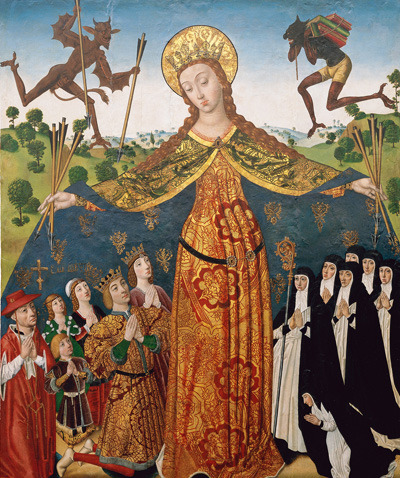

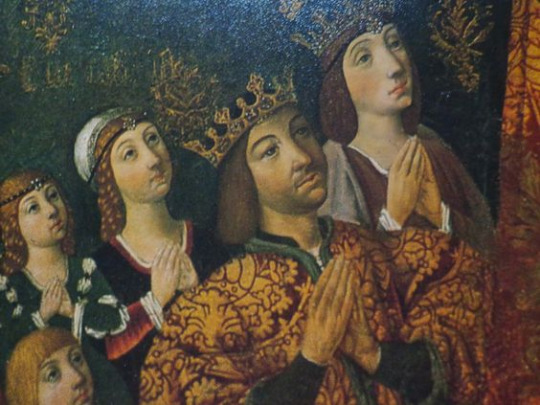
(Sorry couldn’t find closeup on painting after conservation work was carried out.)
I strongly suspect this was painted before Maria was born in 1482(hence her being excluded). Juana would be less than 3 years old. (she looks way taller, if you realise where her dress ends, but in face it is little child. While yes, it is highly stylized, it is not bad likeness. Just not great one either.
In iluminations darkening of pigments occured less frequently:
Juana and her parents supposedly in 1482(i think 1500+ is more likely):

Juana is also probably one of girls next to her mother in this one:
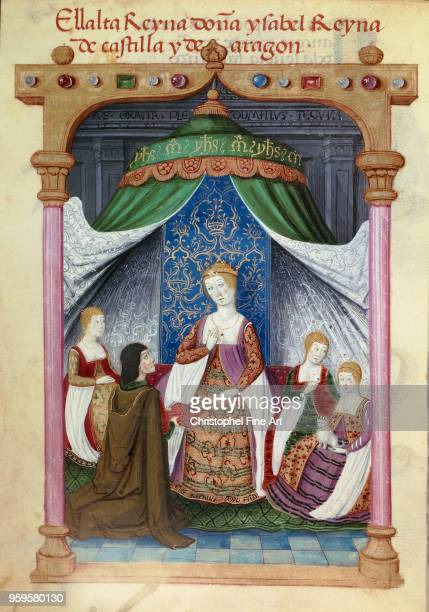
(I think it might be mid to late 1480s, but supposedly 1482)
However in iluminations aside from hair colour and skintone and perhaps period fashion, don’t believe anything.
Juana and Philip, with 3 of their daughters

Their daughters didn’t arrive to Spain with their parents, and youngest was one. But nobody bothered to depict kids at correct age those days. Philip’s skin isn’t supposed to be as dark and his hair was between strawberry blond and red, not reddish brown(but I know from some English examples that even iluminations can sometimes darken and it happened in his case, compare his face and right hadn with one holding book, different shades of skin entirely).But this is another proof that Juana was golden haired, strawberry blond woman with fair skin and not at all brunette.
This ilumination is frequently stated to be Isabella and Ferdinand, but coat of arms behind the couple is Philip’s and you can even see the order of golden shroud underneat it:

Philip’s coat of arms as Archduke and Duke of Burgundy:

Then we have several portraits of Juana as brunette(all darkened):
There are eight different versions of one portrait, or rather there are many copies of it:
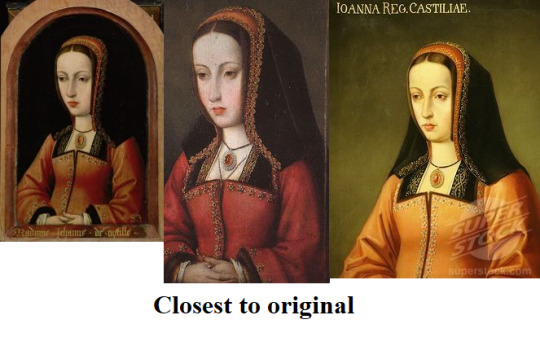


(in the closest to original the gown is lined with fur which is much more noticeable in the severely altered copies(made larger) and missing in slightly altered copies.)
And I can’t tell which one is original, if any! I just know original was probably done cca 1500, due to fashion we see.
Two of them are closest to original(in my opinion), but I suspect both are copies:
Joanna of Castile, likely by Jacob van Lathem, over 1500, Museo Nacional de Escultura, Valladolid(Spain):
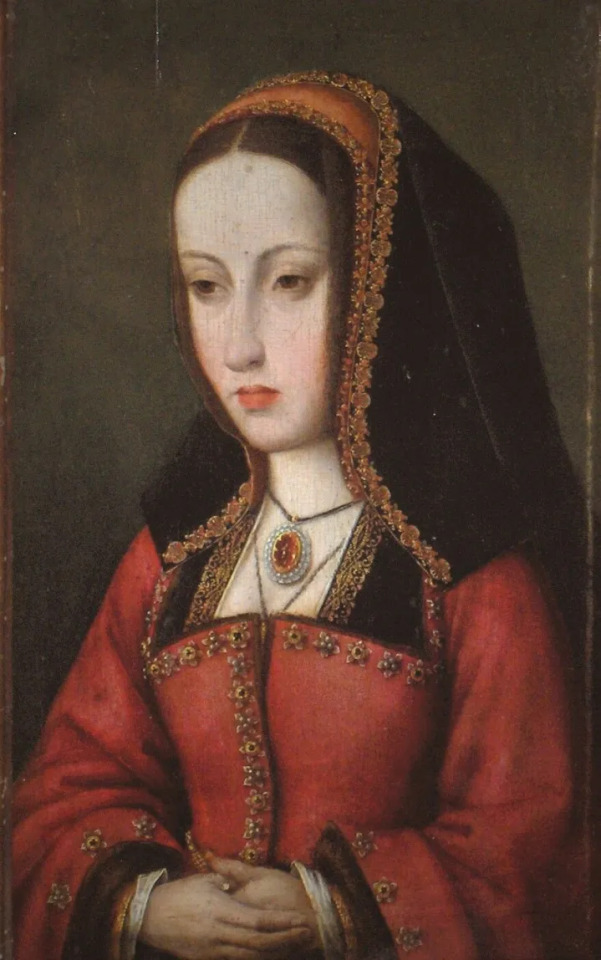
What strikes me as odd is back of hood(back veil). Because I know! that it is not supposed to make that shape! It’s supposed to fall flat copying shape of head.
Like in this painting of Margaret of Austria, done around same time!

2nd portrait i couldn’t find how is called nor who painted it, nor where it is
And I can’t find version where the background isn’t pitch black

Tbh, the hood’s and partlet’s details are so similiar to tryptych bellow that I am not even sure there is an original, and that they aren’t copies of that one!
(and that weird jewelry forming flowers, if it isn’t supposed to mimic the bejewelled piece she has on.)
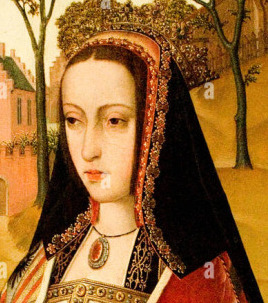
Wings from the Last Judgement Triptych of Zierikzee, by the Master of Afflighem, showing Philip von Habsburg and Juana of Castile c. 1500, held by the Royal Museums of Fine Arts of Belgium
or Volet droit du triptyque de Zierikzee. Avers : Portrait de Jeanne la Folle 1482-1555 ; revers : Saint Martin (entre 1495 et 1506), Musées royaux des Beaux-Arts de Belgique, Bruxelles:
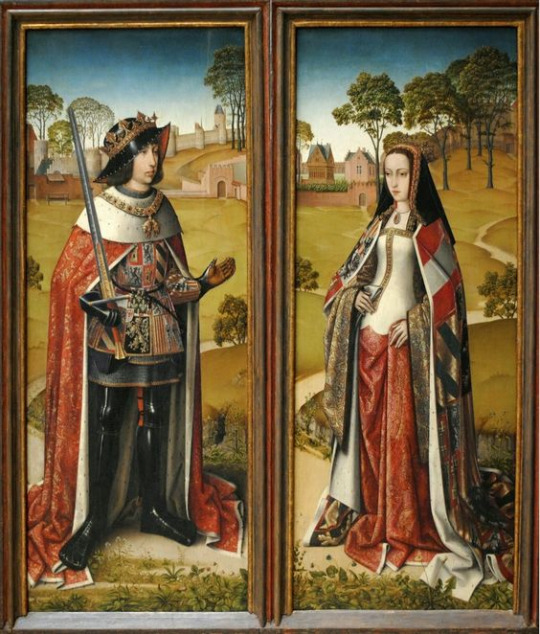
Museum dates it as 1495-1506, but I agree with rest of people who say it is c. 1500-1505.
Because there is coat of arms of Spain shown at their clothes, alongside to coat of arms of places represinting Philip or his family(austria for example). Juana is here already as Princess of Asturias, hence it is painted after her nephew Miguel died in 1500, but before she left for Sain in late 1505. Juana should be here 21-26 years old.
Philip the ‘Handsome’ is here shown with way nicer nose he actually owned, while Juana’s is in very unflattering angle. (Nose is biggest in this angle) and I am not so sure it is her actual nose:
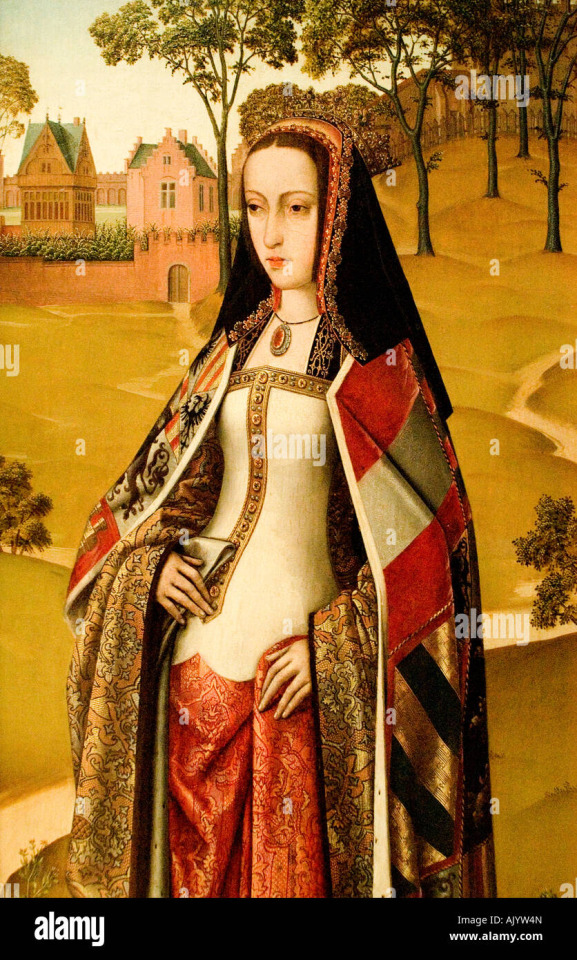
I stumbled upon print of the same painting from 1894 where nose is different:

It is of course possible that black and white version shows painting with later altereations which were removed and revealed that unflattering nose(which might have been original). Problem is, you can better see how fabric of her hood fells on the print than in the painting. With dark shadows which aren’t consistent with fabric touching shoulders.

I suspect the front of hood was repainted, and might have originally been shorter. But even if wasn’t, the lower edge wasn’t the perfectly straight line we see in painting nowadays! Yes, these could be straight and stiffened to keep the shape, but even so it’d bend slightly.
The straight line is big red flag for. Makes me very suspicious.
Unfortunately the museum’s webpage didn’t help to solve the dilema, as they only show very tiny picture of the painting:
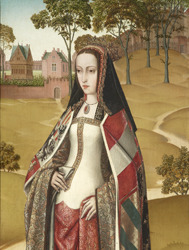
Tryptych despite it’s seemingly good quality, proved for me an unrealiable source. I think it is altered and I do not trust it and I think in the print, it looks like Juana’s nose by Juan de Flandes, but not in version found in museum. It’s hanging too low.
I wonder if there were two versions of thsi tryptych and surviving one isn’t the original. Given how many very well-made copies of Henry VIII’s portraits there are, I think it is possible. (Especially if the copy was done in early 16th century, museum would have no way of knowing their version wasn’t the original.)
The hood is essentially an insignificant detail. But nose isn’t. Because based upon such features you can exclude or include Juana in identification of other still unidentified potraits.
You might think, no undentified potraits exist, they must know them all by now.
But I found one potrait of woman wearing spanish fashion(and for while i thought it might be Isabella’s posthumous depiction), but then I realised it bears striking resemblence to fashion on Juana’s tomb.
Juana’s (and Philip’s) tomb by Bartolomé Ordóñez:
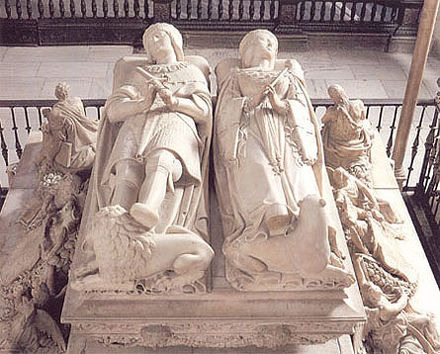
Her tomb was finished within her lifetime(work started 1519), but I can’t figure how without meeting her sculptor achieved such likeness(maybe based upon now lost potraitm but maybe it just seems as good likeness), take it with pinch of salt:

(For example her forehead seems as short as Isabella’s yet we know from portraits it wasn’t that short!)
From this angle you can see cofia on her head:

This angle is most interesting:

It shows Juana with rather long neck(because her head is tilted up and behind, hence it looks way longer than it was, not very natural sleeping pose), with scepter and crown(same as on her mother’s tomb), with probably emerald necklace of arrows(the front piece is missing so either it was altered in Juana’s time as Queen or after she got confined, or by the time sculptor got to see the necklace). The waistline is cca same height as on Isabella’s tomb, and there is some resemblance to praying sculpture of Isabella(because both wear lower gown but I think we need to discuss the sleeves here. It’s as if sleeves were part of upper gown. And Juana is only royal spanish woman depicted in such fashion.
Germaine of Foix in only potrait of her wears without doubt upper gown. But Juana’s is mixture of both lower and upper gown, with rather small slashes and bows or ribbons used over it.
I think this unidentified potrait is Juana:

Portrait of girl by Ambrosius Holbein, supposedly c. 1518 (not even close fashion-wise) was part of the Austrian imperial collection at Ambras Castle, near Innsbruck. But it is now part of Krannert Art Museum at University of Illinois at Urbana-Champaign in USA.

In this case, there is no mixture of lower and upper gown, and it looks very similiar to what Isabella wore towards end of her life, except that cuts from previous style of upper gown are tied together by ribbons and cloth girdle is also tied around the waist(just as it is on the tomb). The headwear is between 1490s and 1520s, lenght of hair points to 1500s. (they got up as 16th century continued). The hair looks like it could be strawberry blond. It’s too yellow under certain light to be regular blond and in the 2nd version I could find, the reddish tint is stronger and it also goes towards either dark blond or light brown. Which is exactly what I’d expect to see from dark shade of golden strawberry blond which I know Isabela, Catalina and Juana had.
The rest of features matches too. (Of course in this angle it is hard to say lenght of neck.)Not so short forehead, rather full lips, small chin, overal face, narrow nose,profound philtrum the very light almost none-existent brows. It matches the 1st two paintings I’ve show you, way better tahn all of her marriage potraits comissioned by Philip combined. It also shows her with possibly blue-grey eyes and the background is same shade as one used by Juan de Flandes. It is not noticable on Juana’s painting(because it suffered some damage to backrgound) but on matching potrait of Philip it is.
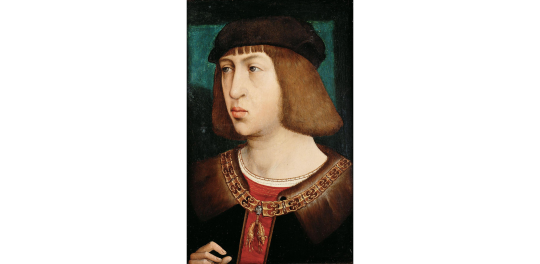
Background shade/colour was thing of fashion, and this would tie the background to late 1490s and 1500s.
It is either misdated or the painting is rather realistic early copy of original done in 1500s based upon probably now lost original by Juan de Flandes(it has big similiarities in features to his painting, that is why I suspect him specifically.)
I am very surprised it hasn’t yet been suggested by professional art historians that it might be Juana! In my opinion, it is. And certainly the nose is not hawk-like in this one.
It’d be done after her return to Spain(because prior Philip wouldn’t allow her to wear spanish fashion, even after she became heir of Spain.) Hence it is 1506-09(in 1509 she was confined for good). I think 1506-1507 is most likely when that painting was made, while Juana was still free. (I couldn’t find matching for Philip, but that doesn’t prove there wasn’t/isn’t one. Maybe they are just apart.)
And you might have started to get feeling, that the painting seems similiar in some way:

Notice the colums, the shade of background? Sure this is much later copy(from 18th century) of portrait of Catherine of Aragon wearing fashion of cca 1525, colums were guilded and parts of it cut(and possibly changed a bit). But it looks like possibly part of same collection of portraits. Such collection would be full of copies, not originals, but sometimes that is all we have, as originals got destroyed.
It is also important to note than in religious paintings sometimes royals are hidden and this is my another candinate of unidentified portrait of Juana:
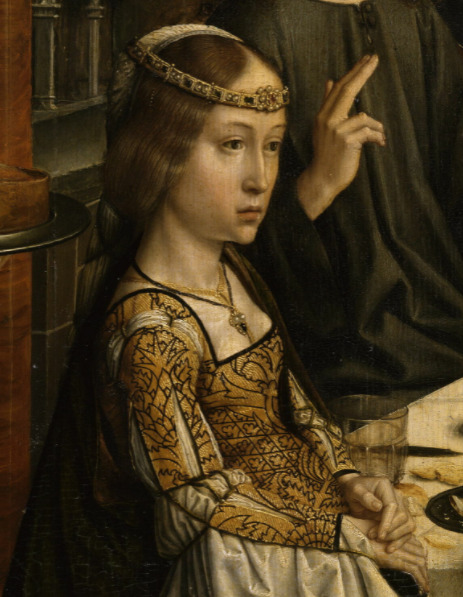
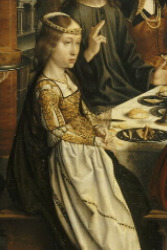
Hidden in painting of Marriage feast at Cana, by Gerard David and Jean Sedano, located in Louvre Museum is this lady dressed fully in spanish atire.
( Les noces de Cana, avec Jean de Sedano, son fils et son épouse).
Now Alonso Sedano is person who painted potrait which I think is unidentified religious painting Isabella. It is posisble Jean Sedano is a relative of his, employed by Isabella or her family. Yes, the painting is dated 1500-1503, but frills of french hood could be also late 1490s and if this is Juana, she looks extremely young. As young as in the first painting in this post. I recon it not even year apart. Hence most most likely this is 1496-1497. And it would make sense for this to be actually yes, religious painting, but celebrating Juana’s wedding to Philip, which occured in 1496.
There is 2nd version of this painting located Cathedral Vieja, Plasencia, Caceres(Spain) and it is said to be done by David Gerard also(that it was made by original painter), but most interesting is the name: Bodas de canna(wedding at Cana) con Los Reyes Catolicos (of Catholic Monarchs). Catholic monarchs is refering to Isabella and Ferdinand. Hence there is direct link between this painting and Juana’s parents. Yes they were pious, but also they could have wished to have painting with their daughter in it.
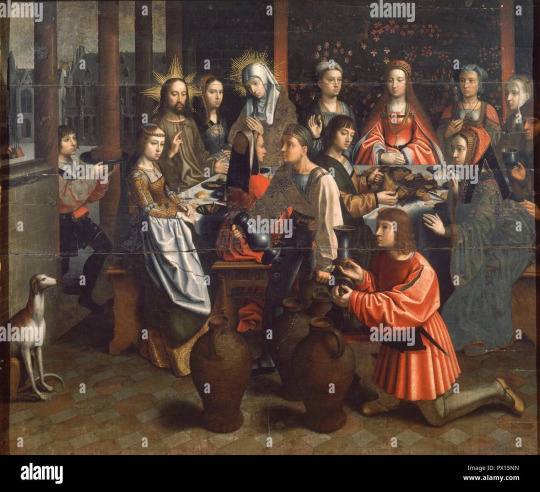
Unfortunately, as it is often the case with spanish museums and galleries, I couldn’t find its webpage nor any better version of this painting.
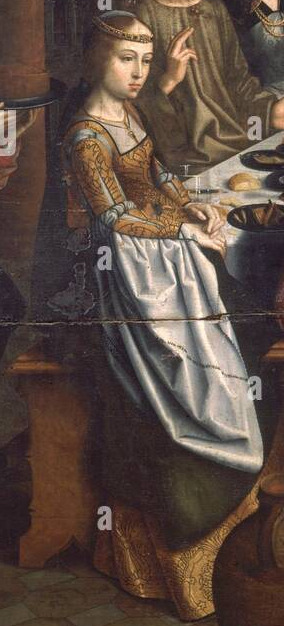
By the way, Philip is not at either painting, probably because there was originally 2nd painting where the feast would continue or because painting got cut. Painting doesn’t seem balanced at all. Proportions etc suggest more is supposed to be towards right. Many figures are actually looking or tilted toward lady in spanish dress. While they should be focused on Jesus and his mother Mary(with halo). Spanish lady is also sat just next to Jesus.
The lady between Jesus and St. Mary would then probably be Margaret of Austria,

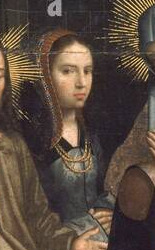
who would in late 1496 travel to Spain to marry Juan, Prince of Asturias but she was not to be happy for long. But she got along nicely in her in laws.
Only the hair are darkened. Otherwise resemblance is there.
Speaking of Margaret, I was not sure if this was her portrait or if it was Juana, but finally I found portrait of younger Philip and it is clear these are the siblings.
(Nose of both got much wider as they grew up.)
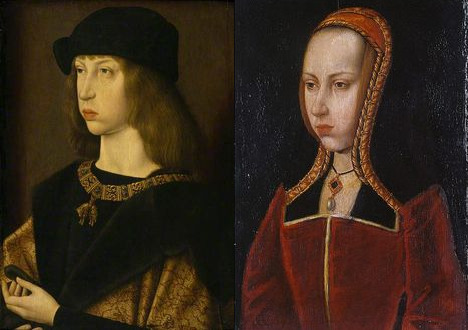
There is some resemblance to Juana, but Margaret’s and Philip’s grandmother was Eleanor of Portugal and through her Margaret and Juana were related on Iberian side, and also they were both related through English blood.
BUT WHAT ABOUT JUANA’s nose? Which one is the real one?
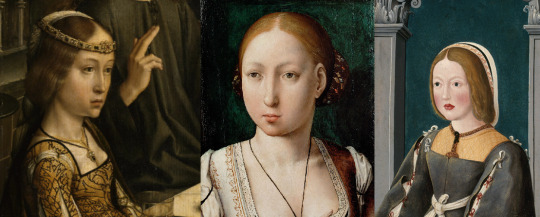
From left it is Marriage at Cana by Gerard David. From front it is Juana as young woman by Juan de Flandes, from right it Potrait of girl is by Ambrosius Holbein.
It’s same very narrow nose, very squeezed nostrils, profound philtrum, etc. It has slightly shorter neck in Ambrosius’ and Flandes’ due to angle doesn’t show the nose isn’t perfectly straight, but these three in my opinion are true likenesses of Juana. There is 4th: stained glass window once adoring window of chapel in her husband’s palace, and you can see nose rather up, profound philtrum, her full lips, etc. It’s good likeness of her as adult.

Just not realiable for comparison with other portraits, but more as guide to what her base features were and what her hair colour was.
And I can only conclude that each depictection where her nosetip is hanging down like Hawk’s beak is altered. Sorry, the famous depictions of Juana, are not true Juana and that very narrow nose on her tomb, is actually hers!
12 notes
·
View notes
Text
“…Catalina, born in the archbishop of Toledo’s palace at Alcalá de Henares on 16 December 1485, was an attentive child who spent much of her childhood in the newly conquered kingdom of Granada alongside her mother. To care for and educate Catalina and her siblings –Juan, Isabel, Juana, and María– Isabel selected members of her own itinerant court who were trained in Latin, religious conduct, and decorous behavior. These women, bound to the queen and her daughters by ties of service and friendship, combined sewing, embroidery, spinning, and weaving with intellectual and cultural pursuits. Andrés de Miranda and Beatriz Galindo supervised the formal education of Isabel’s daughter, but prominent noblewomen shaped the social and cultural education of the infantas.
They were expected to be clever, cultivated and sophisticated but not learned, and to be friends and servants and guides to the cultural norms of life at court. This relationship is not easily defined, with fluid boundaries dependent on personality and experience. Over the course of a lifetime, a noblewoman serving at court could be tutor, mentor, casual friend, close confidante, and as intimate as a favorite sister. The relationship was reciprocal, and not just in terms of monetary compensation. Both sides gained much: the royal family received vital loyal service from noblewomen who, in return met their future husbands from the pool of noblemen in service to the king and infante Juan.
Isabel and Fernando’s children received a rigorous education in an intellectual milieu where literacy was expected and cultural patronage the norm. Household accounts show that Isabel carefully selected and compensated her children’s tutors. Isabel’s servants, Andrés Miranda, a Dominican at the monastery of Santo Domingo (Burgos) and Beatriz Galindo (la Latina, “the Latinist”), were important in educating the children. At age six, Catalina began her studies with the Geraldino brothers. Alessandro accompanied Catalina to England in 1501, served as her confessor, and wrote De eruditione nobelium puellarum (On the Education of Noble Girls, 1501), at Isabel’s request. At age eleven, Catalina owned a breviary. At age twelve she was expected to exercise some discretion and had learned to supervise servants. Her studies included philosophy, literature, and religion, and music (she could play the clavichord and harp).
She could speak French, English, and German in addition to Castilian and Latin, prompting Beatriz Galindo to note that Catalina surpassed her mother in Latin learning. She studied late medieval ideas on virtue, justice, and proper queenly behavior and Christianized versions of Classical philosophy and natural science concerning medical understandings of the differences between the sexes. She would have read, or known of, works that dealt with the education of women such as Juan Rodriquez de la Camara’s El triunfo de las donas (The Triumph of Women, 1443), Alvaro de Luna’s El libro de las virtuosas y claras mugeres (The Book of Virtuous and Famous Women, 1446), Fray Martín Alonso de Córdoba’s Jardín de la nobles doncellas (The Garden of Noble Maidens, 1468), and Francesc Eiximenis’s manual for female instruction, the Carro de las donas (The Carriage of Women, 15th century), that may have been brought to court by Beatriz Galindo.
It is also likely that she read or knew of Juan de Flores’s Grisel and Mirabella, The Slander against Women, and The Defense of Ladies against Slanderers, works in the querelle des femmes genre that were dedicated to an unnamed female reader who may well have been Isabel. Isabel continued to pay annuities to Alessandro Geraldino (“maestro de las ynfantes”) until her death in 1504. The royal account books report expenditures for Catalina from 1478 to 1504 and include books, patronage, philanthropy, alms, as well as clothing and jewelry.
Some of the earliest records that mention Catalina are found in the household accounts of Isabel’s court and date from 1486, just after her birth. They record purchases of fabric for blankets and baby clothes, items for her baptism, shoes, food (honey, silver flatware, and glass cups and the expenses for moving the households of Catalina and her elder sisters Juana and María from Murcia to Valladolid (in 1488) and from Valladolid to Jaén (1489). Álvaro Fernández de Córdova Miralles counted 92 women at Isabel’s court, 61 who served the queen, with thirteen in the household of the infanta María, six for infanta Catalina. The Isabelline court appears to be typical of the age but much smaller than that of later queens, Isabel of Valois (178 women) and Mariana of Austria (over 300 women). Typical also of royal households is a significant number of noblewomen, many of whom were daughters of or married to the highest ranking nobles at court.
…More lowly were Catalina’s attendants –both men and women– caring for clothing, shoes, jewelry, and personal objects (such as books and toys), who were paid between 6,000 and 10,000 annually. What these sums do not show, however, is the marriage gifts (often monetary, but also valuable objects) bestowed by Isabel, which could be substantial and which men at court did not receive. Gentlewomen of modest rank, such as Francisca de Torres, Juana de Porras (called Porricas), and Nieta were paid 10,000, 6,000, and 8,000 maravedís on 20 October 1500. Little is known about these women beyond the fact that they were permanent members of the household. They were paid for expenses they incurred to move Catalina’s household from Ecija to Seville, and the same three were paid the same amounts again on 10 March 1501. Nieta may be just a nickname suggests that she is part of the intimate circle around Catalina but probably not a noblewoman.
At the bottom of the social hierarchy are a few slaves and a female dwarf who was first part of infanta María’s court at Lisbon, then came to Catalina’s court in Spain, and moved with her to England where she was known as the Spanish fool. But these women at court were valued highly and respected. After queen Isabel’s death, king Fernando ordered a final set of annuity payments to be paid to the women who had served in Isabel’s court, among them some of the loftiest and lowliest. On 10 June 1504, Blanca Manrique, Aldara de Portugal, Francisca de Ayala, Isabel (daughter of Costança), Marina Ruiz, and Inés (a slave) received payments of an unspecified amount.”
- Theresa M. Earenfight, “RAISING INFANTA CATALINA DE ARAGÓN TO BE CATHERINE, QUEEN OF ENGLAND.”
20 notes
·
View notes